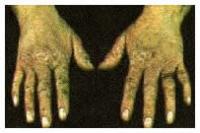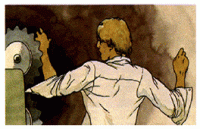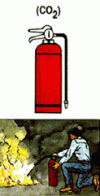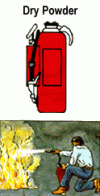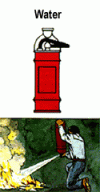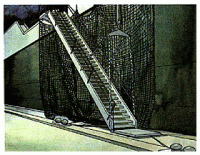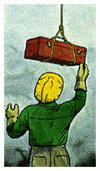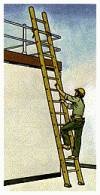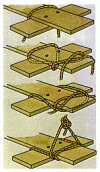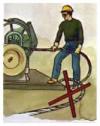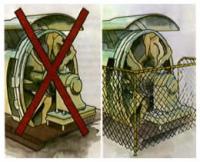Personal Safety on Ships
(PDF, 1.22 MB)
Title: Personal Safety on Ships
Number: TP 5021
Date: 1984
Details: Marine Safety, Transport Canada, Ottawa
Table of Contents
- Forward
- Health
- Working Clothing
- Protective Clothing & Equipment
- Fire Precautions & Fire fighting
- Lifting & Carrying
- Movement about the ship
- Access to The ship
- Entering Enclosed & Confined Spaces
- Tools
- Welding & flame Cutting Operations
- Painting
- Working aloft & outboard
- Dangerous Cargoes
- Falling & Moving Objects
- Mooring
- Hatches
- Lifting & Mechanical Appliances
- Working with Machinery
- Work in The galley
Foreword
All mariners know the hazards of working at sea. Every year more than 1000 marine incidents are reported to the Canadian Marine Administration of Transport Canada.
Although work on board ship can be dangerous, many incidents could be avoided if proper safety procedures, as laid down in Canada's “Safe Working Practices Regulations”, were followed.
This booklet has been prepared by the Canadian Coast Guard to explain those regulations. References to specific sections of the official regulations are included so you can find more detailed information if you need it.
Health
Safe Working Practices Regulations, Section 4(a), 14.
Keeping fit and staying healthy are at least as important on a ship as elsewhere. Illness may reduce your ability to concentrate on a job and increase the risk of accident.
Good health depends on a balance of work, rest and recreation, regular, nutritious meals, adequate sleep; and moderate use of alcohol and tobacco.
Misuse of alcohol or drugs not only affects your general fitness, but also increases your liability to accidents. Never drink alcohol while undergoing treatment with drugs; even common remedies such as aspirin or seasickness tablets may be dangerous when taken with alcohol.
Many serious infectious diseases can be prevented by inoculations and vaccinations, and you should ensure that these are kept up to date. Precautions should be taken against the risk of contracting malaria when visiting certain countries.
Personal cleanliness is also essential, particularly in jobs where prolonged exposure to mineral oils can cause problems, such as dermatitis. You should wash frequently to get rid of the oil. Synthetic detergents, solvents and degreasers, such as turpentine, take the natural oils out of your skin, leaving your hands cracked and vulnerable to damage by other substances. So, use a protective cream or wear rubber or plastic gloves. Other chemicals such as scale and rust
removers have the same effect but can be corrosive; thus, when using these, avoid getting splashes on your face and arms. To prevent infection, clean all cuts
and abrasions, treat them without delay, and protect the areas until they are healed.
When working with asbestos, always wear a face mask and protective clothing.
In hot or humid conditions, take extra salt and drink plenty of water to avoid heat exhaustion and heat stroke, which can be fatal. In tropical areas, take care to avoid the risks of sunburn and sunstroke.
Sufficient clothing for protection from the cold is the first and most important requirement for survival in cold climates. It not only improves working conditions but is most important in combating hypothermia in survival situation.
Working Clothing
Safe Working Practices Regulations, Sections 7(b), 71-74.
In general, the more complete the cover, the better. Working clothes should be comfortable but sufficiently close-fitting so as not to catch on projections or machinery parts when you are working in cramped positions or are moving about the ship.
Gaping pockets, trailing straps, sweat rags, watch straps and rings are easily caught in moving machinery.
Wear proper industrial footwear with slip-resistant soles and reinforced toe caps. Casual shoes such as sandals, moccasins and filip-flops are dangerous on board ship because they offer little protection and add to the risk of tripping or slipping on ladders.
Wear suitable gloves to protect against the dangers of ropes, sharp or rough objects, acids and chemicals Wet or oily gloves may be slippery, however, and so you should take care, especially when climbing ladders.
Protective Clothing & Equipment
Safe Working Practices Regulations, Sections 71-74.
The Code of Safe Working Practices lists different types of work where protective clothing or equipment may be needed.
For head protection, there is either the bump cap - an ordinary cap with hard, penetration-resistant shell - or a proper safety helmet. The bump cap protects against knocks and bruises when you are working in confined spaces such as the main engine crankcase or a double-bottom tank. But in areas with more serious risks you should wear a proper safety helmet. Where the only risk is long hair becoming entangled in machinery a third type of head gear - the safety cap - is good enough, but offers no protection against head injury.
Always wear goggles or combined face and eye protectors to protect your eyes when you are welding, grinding, scaling or when there is a risk of splashes from chemicals. When working in noisy environments such as the engine room, you should wear proper hearing protectors. Ear muffs are generally more effective than ear plugs.
You should also use dust masks, respirators or breathing apparatus when working in dusty or toxic atmospheres, or with paint sprays. Remember, protective clothing is provided for your safety; be sure to use it.
Fire Precautions & Fire fighting
Safe Working Practices Regulations, Sections 33-41.
Fire at sea is one of the worst hazards. Don't invite fire by letting rubbish accumulate in corners. Keep your quarters clean and tidy. Piles of oily rags and waste can catch fire by themselves if left long enough in open air. Don't keep inflammable materials like paint or solvents in your cabin. Keep clothing and other articles away from direct sources of heat. A discarded match or cigarette can start a fire, so always use an ashtray or some other suitable container, and make sure that you put out lighted matches and cigarettes before leaving them. Never smoke in your bunk. Crewmen have died because they fell asleep while smoking in their beds. At work, smoke only in authorized places.
Fires sometimes result from faulty electrical appliances or fittings. If you have a TV or other electrical equipment, disconnect the plugs when you leave the cabin. You should report any defects in equipment at once and leave repair work to qualified persons. Never overload circuits with too many appliances connected to a single socket or plug. When working in machinery spaces, guard against oil spills and leaks.
If you discover fire, raise the alarm at once and, if possible, tackle the blaze with a portable extinguisher. You should then proceed to your emergency station. If caught in smoke and fumes, put a wet cloth over your nose and mouth and crawl along close to the deck where the air is clearer. Be sure that you know where the nearest emergency exits are in your ship.
Smoke detectors are installed for your benefit. Never remove their batteries except for renewal.
Portable Fire Extinguishers
Before you can use a portable fire extinguisher, you must know how to use it - during an emergency there is no time to hunt for the instructions.
First you must make sure that the extinguisher used is the right one for the kind of fire you are fighting. Using the wrong type could result in a much more serious fire, even death. (Some extinguishers may be colour coded to ease recognition)
Next, take up a position where access to the fire is unrestricted but where you can quickly and safely retreat. Crouching and using the extinguisher as a shield will enable you to get closer to the fire, avoiding smoke and heat.
Water Extinguishers
All types of water extinguishers are effective against fires involving free-burning materials such as wood, paper or clothing. But you must not use them for any electrical fire or one involving flammable liquids.
Direct the jet at the base of the flame and keep it moving across the area of the fire. If the fire is spreading vertically, attack it at its lowest point and follow it up. Look for any hot spots after the main fire is extinguished.
Foam Extinguishers
Foam extinguishers are designed to extinguish fires by blanketing them with a layer of foam to exclude air. Use them against burning flammable liquids, but not on fires involving live electrical equipment. When using a foam extinguisher on an oil fire, direct the stream of foam across the fire to strike a vertical surface or obstruction behind it. If this is not possible, allow the foam to drop down and lie on the surface of the liquid with a gentle sweeping motion. Do not direct the jet into the liquid because this would drive the foam beneath the surface where it would be useless, and also might splash the fire around.
Dry Powder and Carbon Dioxide (CO2) Extinguishers
Both dry powder extinguishers and CO2 extinguishers act mainly as smothering agents, depriving the fire of oxygen. They are effective against fires in electrical equipment or on burning liquids. On fires involving either liquid in containers or spilled liquids, direct the jet or discharge horn toward the near edge of the fire. Then, with a rapid sweeping motion, drive the near edge toward the far edge until all flames are extinguished. For fires in electrical equipment, direct the jet or discharge horn straight at the fire.
If the fire has taken hold and you cannot use a portable extinguisher, close doors and other openings feeding air to it. Unless it is too dangerous to do so, remain near the fire to keep the area sealed off and to identify the fire's location when the fire party arrives.
Electrical equipment
Burning liquids
Electrical equipment
Burning liquids
Wood, paper or clothing
Wood, paper or clothing
Lifting & Carrying
Safe Working Practices Regulations, Section 90.
Each year, many seafarers are injured through incorrect lifting, carrying, pulling and levering of loads. Remember, your legs are much stronger than your back, and so they should take the strain in any lifting operation.
The main principles are:
- Stand close to the load with your feet slightly apart, so that the lift will be as straight as possible.
- Bend your knees, keeping the back straight to ensure that your legs do the work. Keep your chin tucked in.
- Grip the load with your whole hand, not just fingertips. If there isn't enough room under a heavy load to do this, place a piece of wood underneath first.
- Lift by straightening your legs, keeping the load close to your body. Don't twist your body. If the load is too heavy, ask for help in lifting it. Never carry a load in such a way that you cannot see where you are going.
Movement about the ship
Safe Working Practices Regulations, Section 25.
Most accidents on board ship are caused by slips, trips or falls. Watch for slippery patches, obstructions on deck, trailing leads and unguarded openings. Be on guard against any sudden lurch or movements of the ship. On stairs and in companionways, keep one hand free to grasp the handrail. When climbing vertical ladders, you should carry equipment on an equipment belt, leaving your hands free to climb. Wearing proper safety shoes will help prevent slipping or tripping.
Prevention is better than cure, so always try to keep the decks clear and uncluttered. You should properly secure or stow away all loose equipment. Clean up spillage and spread sand over icy or slippery areas.
Openings through which a person might fall, such as an open hatchway, or in the engine room where floor plates have been removed, should be effectively fenced or guarded. There should be adequate lighting on board wherever you are working or moving about.
Keep clear of operations if you are not involved, especially during mooring and cargo handling or when work is being done aloft.
Access to the ship
Safe Working Practices Regulations, Section 56.
Statistics show that seafarers are more likely to drown in port than at sea and their danger is greatest when returning from a night ashore. Accidents may happen at any time, however, if gangways or accommodation ladders are not properly rigged, secured and fenced, with adjustments made to take account of tidal movements or changes of trim and freeboard.
Wherever practicable, rig a safety net. If the means of access goes over the rail, firmly fix the bulwark steps, with their fencing continuous from the gangway so that there is no gap to fall through. Do not use portable ladders and other makeshift arrangements unless absolutely necessary. If these are required, take great care in their assembly and use. For example, ladders should extend at least one metre above the upper landing place; you must secure them against slipping sideways.
There also are hazards on the dock, especially in container berths. Avoid the dock edge as much as possible. Where designated routes are marked out, use these; avoid shortcuts underneath straddle carriers.
Entering Enclosed & Confined Spaces
Safe Working Practices Regulations, Sections 30-32.
Many deaths have occurred in recent years when crew members have entered spaces where the air could not support life. Such spaces are likely to be short of oxygen; some may contain asphyxiating or toxic gases. This does not apply just to pumprooms or to tanks that have contained petroleum or chemicals.
Some casualties have occurred recently in cargo spaces containing, or that have contained, seemingly harmless cargoes such as steel cuttings, wood chips, tallow and even vegetables. Any confined space may be deficient in oxygen. So don't take a chance. Never enter an enclosed or confined space without the permission of the Master or a responsible officer. These persons must ensure that the space is safe to enter by testing and ventilating before entry, and by having spare breathing apparatus, safety lines and another person standing by.
If, when inside a space, you feel dizzy or have difficulty breathing, get out at once. If you are on standby outside and the person inside collapses, raise the alarm immediately but do not rush in without thinking. Speed in rescue is vital, but putting a second life at risk will just add to the problems. Rescuers must wear breathing apparatus; lives have been lost when precautions were not take despite obvious danger.
Tools
Safe Working Practices Regulations, Sections 5,6,7.
Hand Tools
Always use the right tool for the job and make sure that it is in good condition. Handles of hammers, screwdrivers and chisels should be secure. Wooden handles should be smooth and free of splinters, and the edges of chisels and punches should be clean and true.
Store tools in a suitable tool rack, box or carrier, with cutting edges protected.
Portable Power Tools
Portable power tools can be dangerous unless properly maintained, handled and used. Always inspect the tool and its cable or power supply lead before use and leave repairs to a competent person. Where a safety guard is needed for a particular operation, make sure that it is securely fixed before you begin the work.
Always disconnect the tool from its power supply when not in use or when you change accessories or guards. Never use electrical tools in wet conditions.
Keep electrical leads and pneumatic hoses clear of sharp edges and hot surfaces, or anything else that might damage them. If leads and hoses have to pass through doorways, secure the door open and, where they trail across decks or passageways, suspend them high enough for people to pass underneath. Handle paint sprayers like power tools; don't try to clean them or change nozzles with the power on. Make sure the nozzle is pointing the right way before starting to spray.
Welding, Flame cutting operations & Painting
Safe Working Practices Regulations, Sections 42-46, 77.
All operators should be competent; they should be familiar with the equipment, wear the proper protective clothing and know when special precautions are necessary.
In general, written permission should be obtained for welding and flame cutting not carried out in workshops.
Firefighting equipment always should be close by.
Safe Working Practices Regulations, Section 78.
Paints can contain poisons or irritants, and some solvents produce flammable or potentially explosive vapours that may also be toxic. To be sure that you are aware of any special hazards, and are using the best method of application, always read the manufacturer's instructions, which should be available even if they are not on the paint container.
In general, you should work in well ventilated conditions, and wear appropriate protective clothing when necessary. Remember particularly the risk of eye damage. Do not smoke in interior spaces. Always return the paint to the paint locker after use.
Working aloft & outboard
Safe Working Practices Regulations, Sections 47-53.
Every year there are serious and often fatal accidents involving falls from stages, bosun's chairs, portable ladders, and other working places aloft. You should get into the habit of wearing a safety device. When working outboard or overside, you should also wear some form of personal buoyant device. When coming back on board avoid the temptation to “ride the hoist”. Use a Jacob's ladder, gangway, or accommodation ladder.
Take care to avoid risks to anyone working or passing below. Make sure that tools and stores are sent up and lowered by line in suitable containers, or wear a tool belt.
If working aloft near the funnel, whistle, radio antenna or radar scanner, make sure that the persons in charge of these items know that you are there, so that they can isolate this equipment from the power source to prevent risk.
Ropes
Before working aloft, always inspect and test all rope, whether a safety lifeline, gantline or stage rope. Your life could depend on it!
Many types of artificial and natural fibre ropes are used on ships. All are affected, and some seriously weakened by contaminating substances such as rust removers, bleaches, oils, solvents and detergents. Take care to minimize exposure to these agents.
It also is important to select the right type of rope for the job. Further guidance is given in “The Code of Safe Working Practices” and in the manufacturers' literature.
Cradles and Staging
The modern cradle-type stages are safest because they have permanent guard rails. When using an ordinary plank stage, you should ensure that the materials are strong enough for the job and free from defect. The standard method of rigging the stage is shown below. Before lowering or raising a stage, make sure that other persons on the stage are informed, that the movements are closely controlled, and that safety lines are secured. When they are not in use, stow the stage or the planks in a dry ventilated space away from heat.
Bosun's Chairs
Always inspect the chair and gantline before use. When using a chair for riding topping lifts or stays, make sure that the bow of the shackle, and not the pin, rides on the wire. In any case, seize the pin. Use only your hands, never a winch, to haul a person aloft in a bosun's chair.
Portable Ladders
If you have to work from a ladder, it should rest on a firm base and be secured as close as possible to its uppers resting place. Make sure it is in good condition before use. Use both hands for climbing; carrying tools in a belt or haul them up on a line as with other materials and equipment. It's easy to overreach while working on a ladder; take care that you don't lean out too far and overbalance.
Dangerous Cargoes
Dangerous cargoes and goods are hazardous in different ways. Don't take liberties with any of them. Tanker crews will find useful information in booklets “Safety in Oil Tankers” and “Safety in Chemical Tankers” produced by the International Chamber of Shipping. Self-unloader crews will find more information in “Safe Working Practices for Self-unloaders”.
When dangerous goods are carried with general cargo, they should be labelled and segregated in accordance with the requirements of “Emergency Procedures for Ships Carrying Dangerous Goods”. Keep an eye open for spills, leaks and damage to containers. Report these at once and keep clear until the appropriate action can be taken.
Falling & Moving Objects
Falling and moving object are common causes of serious injury on board. The general rule, not always easy to follow, is to be aware of such possibilities wherever you are working, and find the safest place you can.
You should lash or stow securely anything on board liable to shift or move. Do not leave doors free to swing. Secure hatches open when in use (Code, Chapter 1 & 18). When working cargo, beware of swinging loads and hooks and cargo falling from sets. As much as possible, keep clear and don't work or pass under swinging or suspended loads. When acting as signaller, make sure that the load is secure and that all other persons are clear before giving the signal to hoist.
Mooring
Ropes under strain, during mooring or towing, may “whiplash” with considerable force if they break. This is particularly true of artificial fibre ropes.
During these operations you should always stand well clear of the danger areas, particularly rope bights and the bight between the drum and the fairlead. Artificial fibre ropes, especially polypropylene, also have a relatively low melting point - this can lead to sticking and jumping of turns on the winch barrel. Use the minimum number of turns needed to prevent unnecessary surging.
When working the winch, remain at the controls throughout the entire mooring operation, and be ready to take immediate action to reduce the load if any part of the system appears to be under too much strain or if there is evidence of danger to personnel.
Hatches
Safe Working Practices Regulations, Sections 26, 27.
When you are working on a hatch, make sure that the beams and covers are properly stacked and secured against movement. Also make sure that they are not removed or replaced while work is going on below. Keep well clear of mechanical hatch covers when they are being raised or lowered. Always secure open mechanical covers properly.
Lifting & Mechanical Appliances
Safe Working Practices Regulations, Sections 11, 16-22.
A qualified person should regularly inspect, examine and test all appliances and gear used for lifting, lowering and handling loads on a ship. Records including particulars of such checks should always be kept up to date. Never use any appliance or gear which has not been checked, or is in any way defective. If you notice any defect during use, stop the operation and report the problem immediately. Do not exceed the safe working loads marked on appliances or gear, and follow the directions shown on controls.
Working with machinery
Safe Working Practices Regulations, Sections 19-22.
All dangerous parts of machinery should be securely guarded, and you should make sure that these guards are in position before the equipment is used. The danger of fire in machinery spaces is particularly great, so guard against oil leaks or spills, and accumulations of rubbish.
Never enter machinery space or a refrigerated compartment alone without proper authority. The precautions to be taken should be posted outside the door and must be strictly followed. Before carrying out any repair or maintenance work, make sure that the machinery has been completely isolated from its power source to prevent it from turning or starting accidentally. On pressurised systems, ensure that all pressure has been relieved from the system before opening it up. Post notices at the controls to warn against using the machinery concerned. Do not attempt repairs to any machine or appliance unless you are qualified to do the work. Wear appropriate protective clothing and equipment.
Boiler Blow-back
Safe Working Practices Regulations, Sections 81-84.
Operating instructions should be displayed at each boiler, and any information provided by the manufacturers should be posted in the boiler room.
To avoid a blow-back when lighting, always follow the correct flashing-up procedure. In general, there should be no loose oil on the furnace floor, the oil should be at the correct temperature for the grade being used; the furnace should be blown through with air to clear any vapour, and the special torch for lighting should be used (unless an adjacent boiler in the furnace is already lit. If there is too much oil on the torch, it can drop and cause a fire.
If the oil does not light immediately, turn the fuel supply off and ventilate the furnace for two or three minutes to clear any vapour before trying again.
Electric Hazards
Safe Working Practices Regulations, Sections 61-70.
When working on electrical or electronic equipment on a ship, the risks of electric shock are usually much greater than they are ashore because wetness, high humidity and high temperature (inducing sweating) reduce the contact resistance of the human body. In such conditions, severe and even fatal shocks may be caused at voltages as low as 60 V .
Before starting work on electrical equipment, always isolate it from the power supply by removing the plug from the socket, removing fuses or locking circuit-breakers open. Always test the circuit to make sure that it is dead.
Never work on or near live equipment unless absolutely necessary. Under such circumstances, avoid contact with bare metal; remove your wrist watch and rings and stand on a dry insulating mat if possible.
Take care when using solvents to clean electrical equipment; some are toxic, particularly carbon tetrachloride (which should never be used). Always follow manufacturers' instructions.
When a battery is being charged, it “gases,” giving off hydrogen and oxygen, which form an explosive mixture. You should take care, therefore, not to bring any naked flame into the compartment or use portable electric lamps or tools that might generate sparks. The electrolyte from batteries - whether acidic or alkaline - is strongly corrosive, so you should avoid contact with it.
Work in the galley
Safe Working Practices Regulations, Section 4(a).
Health and Hygiene
Catering staff should maintain high standards of personal hygiene and cleanliness in the galley, pantry and mess rooms.
Slips, Falls and Tripping Hazards
Most injuries to catering staff are caused by slips, trips and falls. Take care when moving about the ship, keep decks and gratings free from grease, spills and rubbish, and wear suitable shoes with slip-resistant soles.
Galley Stores and Steam Boilers
The indiscriminate use of water in hosing down and washing equipment in the galley can be dangerous. Before washing down the deck, make sure that electric ranges and all electrical equipment have been isolated from the power supply.
Always follow the set procedures of lighting oil-fired galley stoves, and keep clear of the burners when lighting them to avoid flashbacks. If the first attempt is unsuccessful, or the burners go out, ventilate the stove before relighting. Ensure that the galley fuel control valve is set correctly and that the stove does not overheat. Don't stand directly in front of an oven when the door is opened; the initial heat blast can cause burns.
You should use range guard rails, particularly in rough weather. Never fill pots and pans so full that the contents slop over when the ship rolls. Cloths for handling hot pans and dishes should be dry; wet ones conduct the heat and this may cause burns.
Do not melt grease in ovens. If forgotten, it may overheat and catch fire. Never use water to put out a grease fire. The water turns into steam, throwing the grease considerable distances, which can cause severe burns and may start a fire. Smother the flames of a grease fire with a lid or fire blanket; turn off the heat source when possible, or remove the container from the source of heat. Otherwise, use a suitable fire extinguisher - a foam, carbon dioxide or dry power type, depending on which is handy.
Catering Equipment
Before using catering machines, make sure that guards are securely in position around dangerous parts. Don't operate electrical equipment when your hands are wet.
When cleaning or removing a blockage from a power-operated machine, first switch off the machine and isolate it from its power supply. Some machines continue to run down for a while after they are switched off, so you should ensure that dangerous parts have come to rest before you clean them.
Knives, Saws, Choppers, etc.
Keep all knives, saws and choppers sharp and clean, and see that handles are secure and free from grease. Store knives in a rack or drawer; do not leave them on benches or submerged in sinks where unseen blades may be grasped.
When chopping foodstuffs, keep your fingers bent in towards your palm with thumb overlapped by forefinger. The knife should be held at an angle so that the movement of blade is away from your fingers. Don't force a meatsaw. Use the forefinger of your free hand to guide and steady the blade. Always be careful when using a chopper or cleaver and pay full attention to what you are doing.
Refrigerated Rooms and Store Rooms
Before entering a refrigerated store room, make sure that someone knows you are there. Secure the door open firmly when handling stores. Never enter a refrigerated room if you suspect that the refrigerant is leaking.
Accidents don't just happen. Most can be foreseen and prevented. No matter how routine your job, make a habit of adopting the recommended safe working procedures.
The Canadian Coast Guard issues public reports on serious casualties and accidents aboard ship. You may find that a few minutes spent reading them will give you some insights into what causes accidents and how to prevent them. Ask your officers if these reports are available.
